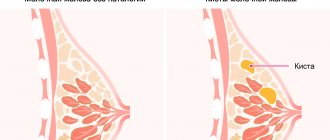Inflammation in the ureter
A urethral cyst in women is a small cystic formation that is localized in the ureteral canal and can provoke accompanying inflammation of the soft tissues of the genitourinary system. On this page you can see what a urethral cyst in women looks like in various clinical cases.
What symptoms occur
The symptoms and clinical manifestations of the paraurethral capsule are in many ways similar to other diseases of urological etiology.
Features of symptoms differ for each sick woman (or man) and may vary depending on the stage of the pathological process.
- At the initial stage, when the infection of the paraurethral gland has just occurred, the clinical manifestations include disruption of the urination process. A woman suffers from dysuria, an increased urge to defecate. Mucous exudate is released from the urethral canal.
- Over time, as the disease develops, the inflammatory process begins to occur with pain and dyspareunia. There is a feeling of a foreign object in the urethral area, increased sensitivity in this area, and the formation of a characteristic compaction.
- The festering capsule forms an abscess, which can independently open into the urethra. If there are blood inclusions in the excreted urine, you should immediately consult a doctor.
- A photo-symptom of a neoplasm is a tumor-like protrusion, which has a spherical shape, soft and elastic consistency, and clear boundaries. Size – 2-4 cm. The capsule can be easily felt by yourself. If you press on it, you can observe the release of mucous exudate.
The neoplasm rarely forms stones that are easily palpated. These can be seen in the urethrogram image.
Why is a paraurethral cyst dangerous?
In general, this is a benign formation, but it can bring a lot of inconvenience to a woman. Among the complications are the following:
- discomfort and pain, including during sexual intercourse;
- frequent “masks” of exacerbations of chronic cystitis;
- formation of abscesses from cysts;
- with large sizes it may burst under pressure;
- formation of fistulas towards the vagina;
- malignancy - the formation of carcinomas (about 5% of all types of cancer in this area).
Paraurethral cysts of Garner's duct cause the least problems, so their excision is rarely resorted to. Even if they reach 3-4 cm in diameter, they do not interfere with a woman’s sexual activity and she can even give birth without complications through the natural birth canal.
Possible consequences
It must be said that a paraurethral cyst can lead to extremely negative complications even after surgical intervention.
The likelihood of negative consequences entirely depends on the formation itself, its size, the presence of infectious and inflammatory processes, and location.
Unpleasant complications arising from the operation may include:
- recurrent infection;
- painful urethral syndrome;
- hematoma;
- bleeding;
- cyst recurrence;
- urethral stricture (such narrowing is accompanied by inflammation);
- urethro- and vesicovaginal fistulas.
Possible complications and prevention
There is no need to wait for the cyst to burst on its own. If a formation is suspected, an urgent visit to the doctor is required to remove the tumor. Numerous reviews confirm the absence of complications in the postoperative period in case of excision of a cyst at the initial stage of development.
If early treatment is neglected, the risk of complications increases, including:
- addition of a secondary infection;
- hematoma formation in the postoperative period;
- hemorrhage;
- relapse of pathology;
- narrowing of the urethral canal, which negatively affects urination;
- fistula formation.
Diagnostics
In some cases, the paraurethral capsule is asymptomatic. Its presence is detected by chance during a routine examination. Diagnosis of this pathological condition is difficult due to similar clinical manifestations with many other urological diseases.
To clarify the diagnosis, the following studies are prescribed:
- Visual examination of the external genitalia. A cystic neoplasm can be localized in the area between the vagina and urethra or on the side wall of the vagina. By palpating these sections, the size, consistency, and level of mobility of the formation are determined.
- Conducting a transvaginal ultrasound examination. In this case, you can find a small retention capsule that does not communicate with the urethral canal.
- Carrying out urethrocystoscopy. The diagnostic measure allows you to examine the condition of the urethra from the inside.
- Carrying out X-ray diagnostics. Necessary for differential analysis of paraurethral neoplasm.
- Carrying out magnetic resonance imaging. The most accurate method for examining cysts, allowing a detailed assessment of their anatomy.
Differential analysis is carried out with such pathologies as bartholinitis, urethritis, cystitis, skineitis, acute and chronic pyelonephritis, adenocarcinoma.
Causes of paraurethral cysts
There are several theories about the occurrence of paraurethral cysts in women. In general, they are cavity formations on the side of the urethra. As you know, the urethra (urethra) literally lies on the anterior wall of the vagina, so such cysts often have a complicated course in this direction (for example, fistulas occur). The causes of cysts are as follows:
- This is a consequence of blockage of the glands of the same name, after a series of changes in which a connection with the urethra is established. First of all, this opinion is due to the fact that cysts are often located precisely in the localization zone of the paraurethral glands in women.
- Injuries to the urethra itself, which lead to disruption of the outflow of secretions from the paraurethral glands. For example, during childbirth at the birth of a large child, when it compresses the surrounding tissues, after the use of various obstetric aids, as well as after operations on the urethra or adjacent tissues (for example, after TVT operations).
However, it is still unclear why paraurethral cysts are detected in women who have not yet given birth and have not had any traumatic factors in the past.
- There are congenital paraurethral cysts, for example, Gartner's duct, cloacogenic. They appear due to non-fusion of the embryonic ducts between the vagina and urethra.
- Presence of an abnormal accessory urethra. In this case, cysts are detected at birth, since they already have significant sizes due to the accumulation of fluid inside.
- Endometrioid ectopia. The presence of foci of endometriosis in the pelvis, as well as its hidden course, can be in the form of paraurethral cysts.
- Hormonal fluctuations. During pregnancy, the paraurethral glands increase significantly in size, and after childbirth they atrophy again. It is believed that such changes provoke the formation of cysts in them.
The opinion of most researchers agrees that if cysts are found in women of the reproductive period who are actively sexually active, they are of an inflammatory nature. Often occur after a gonorrheal infection.
Thus, we can identify risk groups of women who are more likely to form such cysts. These include those who:
- Suffers from chronic inflammatory diseases of the urinary organs - cystitis, pyelonephritis, etc.
- After injuries, bruises in the genital area, including during rough sexual intercourse, after childbirth.
- If you have previously had episodes of sexually transmitted infections.
- Excessive or insufficient adherence to personal hygiene rules.
- If you have immunodeficiency or endocrine diseases (for example, diabetes).
We recommend reading about why Nabothian cysts of the cervix appear. From the article you will learn about what Nabothian cysts are, the symptoms of their presence, and treatment methods.
And here is more information about the types and symptoms of paraovarian ovarian cysts.
Cyst treatment
Treatment of paraurethral cysts is only surgical. Alternative treatment and conservative treatment in this case will not help to completely get rid of the disease. The latter method is used only to eliminate unpleasant symptoms and suppress an active infection.
Excision of the cystic neoplasm should occur together with its membrane. Drainage of the cyst and removal of liquid exudate from its cavity without removing the membrane is not carried out.
The exception is a strong purulent process that prevents the operation. In this case, the contents are first pumped out, antibacterial therapy is carried out, and after the inflammatory process subsides, surgical treatment is performed.
Conservative
Conservative therapy consists of pumping out the contents of the cystic neoplasm and prescribing treatment for the ongoing infection. For the latter purpose, antibacterial therapy is required.
Prescribe Ofloxacin, Norfloxacin, and other drugs from this group. Duration of treatment is up to 2 weeks.
Antibacterial treatment is also prescribed in the preoperative period in order to prevent possible complications.
Operational
Removal of a paraurethral cyst is performed under local or general anesthesia. Surgical treatment is the most reliable, after which the possibility of relapse is minimized.
If the cyst is located in the distant part of the urethral canal, laparoscopic surgery is performed, but more often such intervention is required in the case of formed diverticula or abscesses.
After removal of the cyst, hospitalization is required for another 5-7 days. For 2 days, a catheter is placed in the urethra to remove urine. Prohibition on sexual activity and heavy physical activity – up to 2 months.
Symptoms in women and girls
All manifestations of these cysts are nonspecific, so treatment and diagnosis are often based on another disease.
Symptoms of the presence of paraurethral cysts may vary between glands. The following is most often observed:
- frequent urination, pain as in the clinical picture of acute cystitis or urethritis;
- pathological discharge from the urethra;
- swelling and pain in this area;
- pain in the lower abdomen, in the urethra, in the lower back, during sexual intercourse;
- discharge of pus from the urethra;
- feeling of pressure in the vagina;
- the appearance of blood in the urine.
In many cases, urethral syndrome occurs, which includes the following symptoms:
- burning and pain in the urethra;
- discomfort in the perineum and above the pubis;
- some difficulty urinating, a feeling of incomplete emptying of the bladder;
- urge to go to the toilet when the bladder is not full.
If paraurethral cysts reach significant sizes (5 mm or more), they are palpated as tumors in the form of balls, with clear boundaries, soft-elastic consistency, and are located closer to the outer urethra. They are easy to feel from the vaginal side, and during pressure, secretions, including purulent ones, can come out of the urethra. Stones can form in cysts.
Expert opinion
Daria Shirochina (obstetrician-gynecologist)
Up to 20% of detected parautrel cysts are asymptomatic. The absence of any complaints from the woman is an indication for dynamic monitoring of the formation, and not for its removal.
Thus, the clinical picture of the presence of parautral cysts in 2/3 of cases occurs under the guise of chronic cystitis. This is due to the fact that urine stagnation occurs in this area - a favorable condition for the proliferation of bacteria. Moreover, even if the formation was caused by some specific flora (for example, after gonorrhea), urine cultures only reveal pathogens that are standard for urinary infections - streptococci and staphylococci, E. coli, etc.










